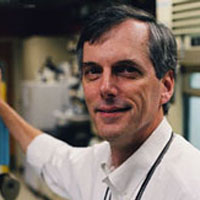Conférence du Professeur Thomas Hoye (Minnesota)

Titre: What’s new with the hexadehydro-Diels-Alder (HDDA) reaction
Endroit : Pavillon Roger-Gaudry, salle G-815 à 11 h
Hôte : Shawn Collins
Cette conférence sera prononcée (en anglais) par le Professeur Thomas Hoye du département de chimie de l'Université du Minnesota.
RÉSUMÉ: We have developed a process we call the hexadehydro-Diels–Alder (HDDA) reaction.[1] This net [4+2] cycloisomerization produces an o-benzyne derivative, which then is quickly captured in a trapping event. The HDDA reaction is a rare example of a transformation that generates a high-energy, reactive intermediate by way of a highly exergonic (ca. –50 kcal•mol-1) reaction! The two-stage benzyne generation/trapping cascade results in the rapid assembly of structurally complex benzenoid products. This chemistry is both preparatively valuable and mechanistically enlightening. It also allows fundamentally new modes of benzyne reactivity to be uncovered.[2],[3],[4]
In this lecture I will emphasize the role that unanticipated observations and outcomes have played in leading to these developments. I will also describe, selected from among the following, a number of our more recent studies:
• three-component reactions[5]
• natural product synthesis[6]
• natural product derivatization reactions[7]
• the photochemical HDDA reaction
• organic light-emitting diode (OLED) components that electroluminesce ‘deep’ blue[8]
• interrogation of concerted vs. stepwise mechanistic formulations[9]
• the pentadehydro-Diels–Alder (PDDA) reaction[10]
• the domino HDDA reaction
[1] The hexadehydro-Diels–Alder reaction. Hoye, T. R.; Baire, B.; Niu, D.; Willoughby, P. H.; Woods, B. P. Nature 2012, 490, 208–212. (link)
[2] Alkane desaturation by concerted double hydrogen atom transfer to benzyne. Niu, D.; Willoughby, P. H.; Baire, B.; Woods, B. P.; Hoye, T. R. Nature 2013, 501, 531–534. (link)
[3] The aromatic ene reaction. Niu, D.; Hoye, T. R. Nature Chemistry 2014, 6, 34–40. (link)
[4] Mechanism of the reactions of alcohols with o-benzynes. Willoughby, P. H.; Niu, D.; Wang, T.; Haj, M. K.; Cramer, C. J.; Hoye, T. R. J. Am. Chem. Soc. 2014, 136, 13657−13665. (link)
[5] Reactions of HDDA-derived benzynes with sulfides: Mechanism, modes, and three-component reactions. Chen, J.; Palani, V.; Hoye, T. R. J. Am. Chem. Soc. 2016, 138, 4318–4321.(link)
[6] Hexadehydro-Diels−Alder (HDDA)-enabled carbazolyne chemistry: Single step, de novo construction of the pyranocarbazole core of alkaloids of the Murraya koenigii (curry tree) family. Wang, T.; Hoye, T. R. J. Am. Chem. Soc. 2016, 138, 13870–13873. (link)
[7] Reactions of HDDA benzynes with structurally complex, multifunctional natural products. Ross, S. P.; Hoye, T. R. Nature Chemistry in press.
[8] Blue-emitting arylalkynyl naphthalene derivatives via a hexadehydro-Diels-Alder (HDDA) cascade reaction. Xu, F.; Hershey, K. W.; Holmes, R. J.; Hoye, T. R. J. Am. Chem. Soc. 2016, 138, 12739–12742. (link)
[9] (a) Mechanism of the intramolecular hexadehydro-Diels–Alder reaction. Marell, D. J.; Furan, L. R.; Woods, B. P.; Lei, X.; Bendelsmith, A. J.; Cramer, C. J.; Hoye, T. R.; Kuwata, K. T. J. Org. Chem. 2015, 80, 11744–11754. (link). (b) The hexadehydro-Diels–Alder (HDDA) cycloisomerization reaction proceeds by a stepwise mechanism. Wang, T.; Niu, D.; Hoye, T. R. J. Am. Chem. Soc. 2016, 138, 7832–7835. (link)
[10] The pentadehydro-Diels–Alder reaction. Wang, T.; Naredla, R. R.; Thompson, S. K.; Hoye, T. R. Nature 2016, 532, 484–488. (link)
Emplacement : Pavillon Roger Gaudry - Université de Montréal